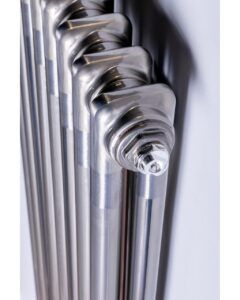Easy Steps on How to Take a Radiator off the Wall
Taking a radiator off the wall may seem like a daunting task, but with the right steps, it can be done easily and safely. Follow these instructions to remove a wall-mounted radiator from your home.
Key Takeaways:
- Removing a radiator from the wall doesn’t have to be difficult or intimidating.
- Proper preparation and the right tools are essential for a successful removal.
- Make sure to drain the radiator and disconnect the pipes and valves before removing it from the wall.
- Inspect and clean the radiator after removal, and consider reinstalling or replacing it.
- If in doubt, consult a professional for assistance.
Tools Needed for Radiator Removal
Before you begin removing the radiator, it’s important to gather the necessary tools. Having the right equipment on hand will make the process much smoother and ensure that you can complete the task efficiently. Here are the essential tools you’ll need for DIY radiator removal:
- Wrench or spanner: You’ll need this tool to loosen the valves and disconnect the pipes.
- Drain pan: To catch any water that may come out when draining the radiator.
- Pliers or adjustable grips: These will be useful for disconnecting the pipes from the valves.
Having these tools ready will save you time and prevent any unnecessary delays or frustrations during the removal process. Once you have everything prepared, you can move on to the next steps of removing your wall-mounted radiator.
Table: Tools Needed for Radiator Removal
| Tool | Description |
|---|---|
| Wrench or spanner | Used to loosen the valves and disconnect the pipes |
| Drain pan | Catches water when draining the radiator |
| Pliers or adjustable grips | Helps in disconnecting pipes from the valves |
“Having the right tools for radiator removal is crucial to ensure a smooth and successful DIY project. By being prepared, you can avoid any unnecessary setbacks and complete the task efficiently.”
Now that you have gathered the necessary tools, you are ready to move on to the next section and prepare the space for radiator removal. Taking the time to properly prepare the area and shutting off the heating system will ensure a safe and hassle-free removal process.
Prepare the Space and Turn off the Heating System
Before removing a wall radiator, it’s important to prepare the space and ensure the safety of the surrounding area. Follow these tips to remove a radiator safely and efficiently:
1. Turn off the Heating System: Begin by shutting off the heating system to prevent any accidents or leaks during the removal process. This will also allow the radiator to cool down before you begin working on it.
2. Protect the Floor: Place a towel or an old sheet underneath the radiator to catch any water, spills, or drips that may occur during the removal process. This will help prevent damage to the floor and make clean up easier.
3. Have a Bucket or Drain Pan Ready: While draining the radiator, it’s important to have a bucket or drain pan nearby to catch the water that comes out. This will help prevent any mess or water damage to the surrounding area.
4. Wear Protective Gear: Before starting the removal process, make sure to wear appropriate protective gear such as gloves and goggles. This will protect you from any potential hazards like hot water or sharp edges.
By following these tips, you can ensure a safe and efficient radiator removal process. Take the necessary precautions, gather the required tools, and make sure to consult professionals if needed.
Drain the Radiator
To ensure a smooth and efficient radiator removal process, it is essential to drain any remaining water from the system. This step will prevent any potential leaks or spills during the removal. Here is a step-by-step guide on how to drain the radiator:
- Locate the drain valve at the bottom of the radiator. This valve is typically a small screw or key-shaped device.
- Place a drain pan or bucket underneath the drain valve to catch the water.
- Attach a hose to the drain valve and ensure it is securely connected.
- Open the drain valve by turning it counter clockwise. The water will start flowing through the hose and into the drain pan.
- Allow the radiator to drain completely. This may take a few minutes depending on the size of the radiator and the amount of water inside.
- Once the radiator is empty, close the drain valve by turning it clockwise.
It is important to note that not all radiators have a drain valve. In such cases, the radiator may need to be removed with some water still inside. To minimize any potential mess, it is recommended to have towels or absorbent materials on hand to soak up any water that may spill during the removal process.
By following these steps to drain the radiator, you can ensure a clean and safe removal process without any water-related mishaps.
| Step | Description |
|---|---|
| 1 | Locate the drain valve at the bottom of the radiator. |
| 2 | Place a drain pan or bucket underneath the drain valve. |
| 3 | Attach a hose to the drain valve. |
| 4 | Open the drain valve and let the water flow into the drain pan. |
| 5 | Allow the radiator to drain completely. |
| 6 | Close the drain valve. |
Disconnect the Pipes and Valves
Once the radiator is drained, it’s time to disconnect the pipes and valves. This step is crucial to ensure the safe removal of the wall-mounted radiator. Using a wrench or spanner, loosen the nuts on the valves and disconnect the pipes from the valves using pliers or adjustable grips. It’s important to have a cloth or towel on hand to catch any remaining water that may come out during this process.
Take your time when disconnecting the pipes and valves, as they may be tightly secured.
Apply steady pressure and turn the nuts counter clockwise to loosen them. If you encounter any resistance, use a lubricant such as WD-40 to ease the removal. Once the nuts are loosened, carefully disconnect the pipes from the valves and set them aside.
Remember to label or mark the pipes and valves before disconnecting them. This will make the reinstallation process easier when the time comes. It’s also a good idea to take photos or make a diagram to ensure the correct reconnection of the pipes and valves. This will help prevent any confusion or mistakes during the reinstallation process.
| Pipe | Valve |
|---|---|
| Hot Water | Thermostatic Valve |
| Cold Water | Lockshield Valve |
| Central Heating | Manual Valve |
In case you encounter any difficulties during the disconnection process, consult a heating professional or plumber for assistance. They have the expertise and experience to handle any challenges that may arise. It’s always better to seek professional help rather than risk causing damage or injury.
Remove the Radiator from the Wall
Now that you have disconnected the pipes and valves, it’s time to remove the radiator from the wall. Before you begin, check for any brackets or fixings that may be holding the radiator in place. Use the appropriate tools, such as a screwdriver or wrench, to remove these brackets. Take care to ensure the radiator is properly supported and stable during the removal process.
Once the brackets are removed, carefully lift the radiator off the wall. It may be heavy, so it’s important to use proper lifting techniques and ask for assistance if needed. Place the radiator in a safe location, away from any obstructions or hazards. Keep in mind that the radiator may still contain some water, so be cautious of any drips or spills.
Table: Steps to Remove the Radiator from the Wall
| Step | Description |
|---|---|
| 1 | Check for brackets or fixings holding the radiator in place |
| 2 | Use the appropriate tools to remove the brackets |
| 3 | Carefully lift the radiator off the wall |
| 4 | Place the radiator in a safe location |
Once the radiator is removed, you may notice that there is a gap where it used to be. This is normal and can be filled with filler or plaster for a seamless finish. If you plan to reinstall the radiator in the same location, make sure to clean the wall and any remaining pipes before doing so. If you are replacing the radiator, consult a heating professional or plumber for assistance with the installation.
Removing a radiator from the wall requires careful handling and attention to detail. By following the steps outlined in this section, you can safely and effectively remove the radiator from your home. Remember to take precautions, gather the necessary tools, and seek professional help if needed. With patience and care, you can successfully complete the radiator removal process.
Inspect and Clean the Radiator
After successfully removing the radiator from the wall, it’s important to take the time to inspect and clean it before considering whether to reinstall or replace it. This step ensures that the radiator is in good condition and ready for future use.
Inspect for Corrosion or Damage
Begin by carefully examining the radiator for any signs of corrosion or damage. Look for rusting, flaking paint, or leaks. Pay close attention to the connecting pipes, valves, and brackets as well.
If you notice any corrosion or significant damage, it may be time to consider replacing the radiator. Corrosion can weaken the structure and efficiency of the radiator, compromising its ability to heat your home effectively.
Cleaning the Exterior and Interior
Next, clean the exterior and interior of the radiator to remove any dirt, dust, or debris that may have accumulated over time. Start by using a soft brush or cloth to gently wipe away loose particles and cobwebs.
If the radiator has stubborn stains or grime, mix a solution of warm water and mild detergent. Dip a cloth in the solution and gently scrub the surface, taking care not to damage or scratch the radiator. Rinse the cloth thoroughly and wipe away any soap residue.
Repaint or Consider Replacement
Once the radiator is clean and dry, you have the option to repaint it if necessary. Choose a high-quality radiator paint that can withstand high temperatures and follow the manufacturer’s instructions for application.
If the radiator is in good condition and matches your home’s decor, you can proceed with reinstalling it following the steps in reverse order. However, if the radiator is severely damaged or outdated, it may be more practical to replace it with a newer, more efficient model.
Remember, if you’re unsure about reinstalling or replacing the radiator, it’s always best to consult a heating professional or plumber for their expertise and guidance.
| Pros of Cleaning and Reinstalling the Radiator | Pros of Replacing the Radiator |
|---|---|
| • Cost-effective option | • Improved energy efficiency |
| • Preserves original aesthetics | • Modern designs and features |
| • Maintains consistent heat output | • Warranty for peace of mind |
| • Suitable for minor repairs | • Long-term cost savings |
Reinstall or Replace the Radiator
After cleaning and inspecting the radiator, you have the option to either reinstall it or replace it with a new one. Depending on the condition and efficiency of the radiator, you can make an informed decision about what will work best for your home.
Reinstalling the Radiator
If you choose to reinstall the radiator, follow these steps to ensure proper installation:
- Begin by attaching the brackets or fixings to the wall. Make sure they are securely fastened.
- Gently lift the radiator and align it with the brackets. Carefully lower the radiator onto the brackets, ensuring a snug fit.
- Reconnect the pipes to the valves, tightening the nuts to secure the connections. Use pliers or adjustable grips to ensure a tight seal.
- Once all connections are secure, turn on the heating system and check for any leaks. If there are no leaks, your radiator is successfully reinstalled.
Replacing the Radiator
If you decide to replace the radiator, it is advisable to consult a heating professional or plumber for assistance. They can help you choose the right radiator for your home and ensure a proper installation. Replacing a radiator involves disconnecting the old radiator and installing the new one, which may require some adjustments to the pipework and valves. It is important to hire a professional to ensure the job is done correctly and avoid any potential issues.
Whether you choose to reinstall or replace the radiator, it is recommended to follow the manufacturer’s instructions and seek professional help if needed. A properly installed radiator will not only provide efficient heating but also enhance the overall comfort of your home.
| Reinstalling the Radiator | Replacing the Radiator |
|---|---|
| Pros | Pros |
|
|
| Cons | Cons |
|
|
Conclusion
Removing a wall-mounted radiator may seem intimidating, but with the right steps and precautions, you can easily and safely take a radiator off the wall. By following the instructions provided in this article, you’ll be able to successfully remove the radiator from your home.
Start by gathering the necessary tools, such as a wrench or spanner, drain pan, and pliers or adjustable grips. Prepare the space by turning off the heating system, protecting the floor with a towel or sheet, and having a bucket or drain pan handy to catch any water.
Draining the radiator is the next step, either through a drain valve or by removing the radiator with water still inside. Disconnect the pipes and valves using the appropriate tools, and carefully remove the radiator from the wall by removing any brackets or fixings.
After removing the radiator, take the opportunity to inspect and clean it. Look for signs of corrosion or damage, clean the exterior and interior, and consider repainting or replacing the radiator if needed. Finally, you can choose to reinstall the radiator or consult a professional for assistance with replacement.
To summarize, removing a wall-mounted radiator requires careful preparation, the right tools, and a step-by-step approach. By following these instructions, you can confidently tackle the task of radiator removal and make any necessary changes to your home’s heating system.
FAQ
What tools do I need to remove a wall-mounted radiator?
To remove a wall-mounted radiator, you will need a wrench or spanner to loosen the valves, a drain pan to catch any water, and a set of pliers or adjustable grips to disconnect the pipes.
How do I prepare the space before removing the radiator?
Before removing the radiator, make sure to shut off the heating system and allow the radiator to cool. Place a towel or old sheet underneath to protect the floor from any spills or drips.
How do I drain the radiator?
To drain the radiator, locate the drain valve at the bottom and attach a hose to it, leading into a drain pan or bucket. Open the valve to release the water. If there is no drain valve, you may need to remove the entire radiator with some water still inside.
How do I disconnect the pipes and valves?
Use a wrench or spanner to disconnect the valves from the radiator. Loosen the nuts and disconnect the pipes from the valves using pliers or adjustable grips. Have a cloth or towel on hand to catch any remaining water.
How do I remove the radiator from the wall?
Check for any brackets or fixings holding the radiator in place, and remove them using the appropriate tools. Carefully lift the radiator off the wall and place it in a safe location.
What should I do after removing the radiator?
Take the opportunity to inspect and clean the radiator. Check for any signs of corrosion or damage. Clean the exterior and interior using a soft brush or cloth. If needed, repaint the radiator before reinstalling it or consider replacing it altogether.
Can I reinstall the radiator after removing it?
Yes, if you choose to reinstall the radiator, follow the steps in reverse order, making sure all connections are secure. If you are unsure, consult a heating professional or plumber for assistance.
Is removing a wall-mounted radiator difficult?
Removing a wall-mounted radiator may seem intimidating, but by following these easy steps, you can safely remove the radiator from the wall. Remember to take necessary precautions, gather the right tools, and consult professionals if needed. With patience and care, you can successfully remove a radiator from your home.




